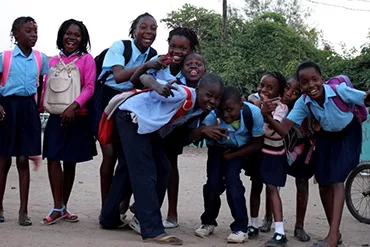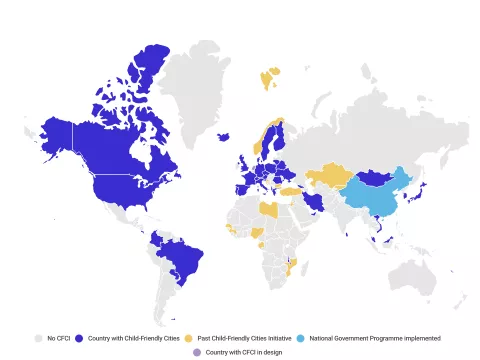Steps
Building a child friendly city

The exact process of building a child friendly city or community will depend on the local context and will be influenced by factors such as the political environment, administrative structures, population size and available resources. Common steps include:
- Assessing the situation of children, including them in the process
- Prioritizing actions and including them in the local development plan (Synthesis Action Plan for Children)
- Implementing the plan with relevant municipal stakeholders including children themselves
- Assessing the results for children
Developing a Child Friendly Cities Initiative under the UNICEF banner requires establishing a partnership with UNICEF and obtaining UNICEF recognition if recognition criteria are met*.
Learn more about the steps in the UNICEF Guidance Note.
* In assessing any potential partnerships, UNICEF is guided by its commitment to protecting children first and foremost. While UNICEF welcomes and supports all efforts to advance child rights, advancements in one area do not compensate for child rights violations in another.
Assessment
If a local government decides to engage in partnership with UNICEF through the Child Friendly Cities Initiatives, a local situation analysis is carried. It establishes an understanding of the specific deprivations and child-rights issues faced by children, young people and their families in the territory and of the context, and addresses the roles and decision-making processes of the local government and other important stakeholders.
The local situation analysis will support the identification of opportunities for interventions for children at the local level. It informs the development of the local development plan, establishes the baseline against which progress and impact will be monitored and evaluated, provides evidence for policy-making, and identifies needs for local capacity development.
Getting Started
Managing and coordinating the CFCI requires dedicated human resources. Whenever possible, it is good practice to build on existing structures and coordination mechanisms.
To support the implementation and coordination of CFCI activities, it is recommended that the following management and coordination structures are established: national coordination body, local steering committee and local CFCI secretariat. These structures need not necessarily be newly established but may be incorporated within existing structures if this is more efficient, and the configuration can be adjusted to best meet local needs.
Planning
Based on the findings of the child-rights situation analysis, including targeted child-related priorities, goals and objectives in the local development plan shapes programmes for children. This will provide stronger better-targeted programmes and more impactful results than programmes based on assumptions.
The CFCI-related activities should be an integral part of the main local development planning and budgeting cycle, ensuring that child-responsive goals, objectives and actions are reflected in the local government strategic priorities and are supported by adequate human and financial resources allocated for their implementation. Integrating the CFCI in existing planning processes and structures enables better and more effective child-responsive local strategies and helps ensure sustainability.
Implementation
Once the local government’s local development plan is finalized and agreed upon, the next stage is for the CFCI implementing partners to accomplish the goals and objectives identified within their area of responsibility, with a focus on meeting agreed deadlines and respecting available budgets.
The implementation process should integrate the following approaches:
- Child-friendly laws and policies: Local governments should progressively work towards ensuring that all relevant aspects of the legal framework and policies under their control promote and protect child rights. Where there is limited or no authority for local governments to influence legal frameworks at the local level, their role will be to collect data and evidence, and use it to advocate for policy changes with subnational and national governments that have the decision-making powers to implement the needed changes.
- Inclusive child participatory mechanisms and processes: Participation lies at the heart of building a child friendly city. The active engagement of children, including those that are marginalized and vulnerable, is essential if the policies, services and facilities that they use or that affect them are to reflect and address their concerns, ideas and needs. Establishment of a functional and effective child and youth participation mechanism is an essential part of the CFCI implementation.
- Community empowerment: The CFCI should apply a whole-community approach, as it involves a representative group of stakeholders directly or indirectly working with children. This takes place by inviting local civil society organizations, community groups, academia and local businesses to participate in the local Steering Committee.
- Capacity building to create sustainable results for children: The long-term objective of the CFCI is to strengthen the capacity of local governments and relevant actors to advance child rights. This capacity building takes place throughout the various phases of the CFCI cycle and can include guidance, technical assistance, trainings, and knowledge and peer exchange with other Child Friendly Cities.
- Elimination of discrimination and promotion of equity: Active measures to eliminate discrimination and promote equity by working to guarantee equal opportunities and equal access to all services and targeting the children and their families living in marginalized and vulnerable situations should be demonstrated through policies and actions by the local government.
- Communication, awareness raising and advocacy: Child rights must be known and understood by all stakeholders. Local government decision makers,
public servants, experts, civil society organizations, parents, caregivers and children need to not only be aware of child rights, but also understand the concept and be able to put their understanding of child rights into practice in everyday situations. Local governments should incorporate community mobilization and awareness-raising activities throughout the CFCI process to build interest and strengthen knowledge in the CFCI process and child rights.
Measuring Impact
The effectiveness and impact of the CFCI can only be understood if systems are in place to measure the positive changes (impact) on children’s lives following the implementation of the CFCI, at both the local and subnational levels, and potentially at the national level. The evidence of progress, results and impact for children generated through the monitoring and evaluation can be used for advocacy and encouraging other municipalities and the national government to adopt measures to promote and strengthen child rights.
Involving all local partners and stakeholders, including children and young people, in the process of monitoring of CFCI implementation is important as it leads to better accountability and transparency at the local level.




